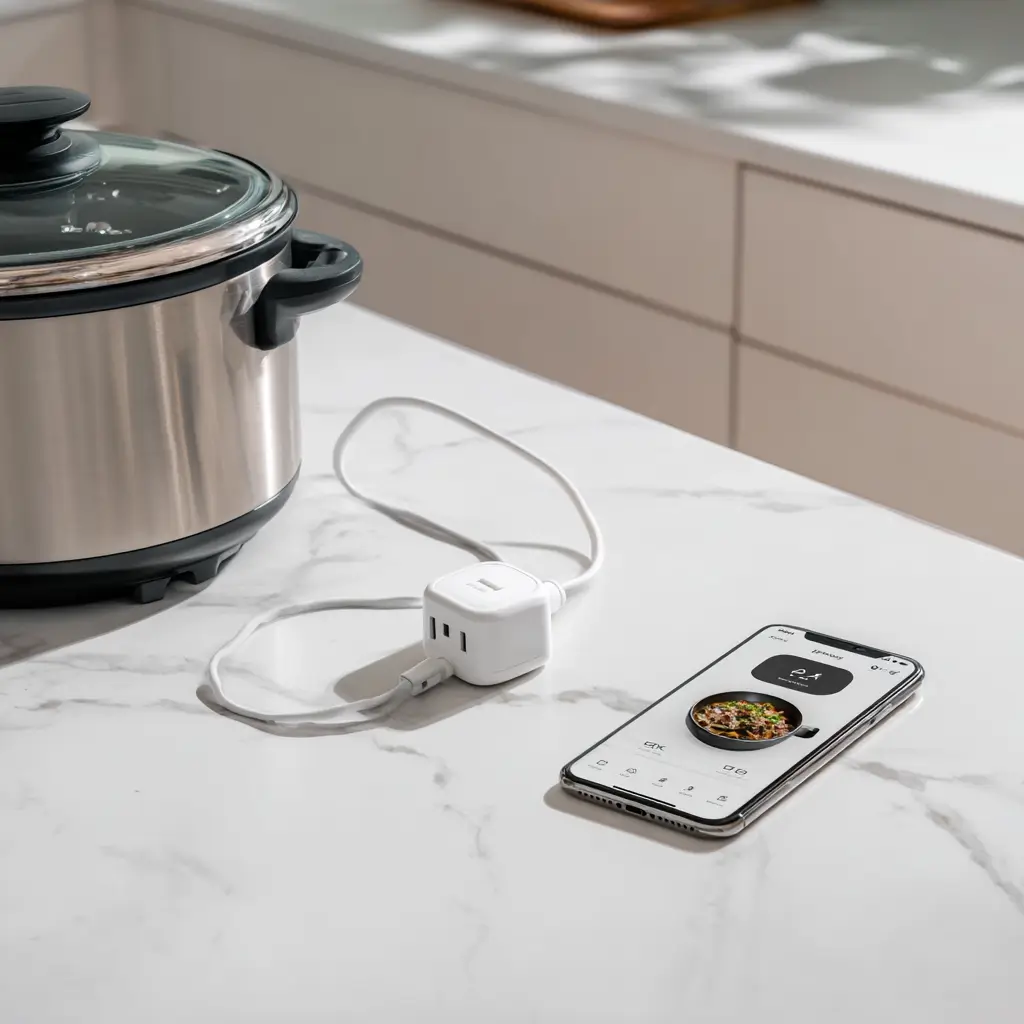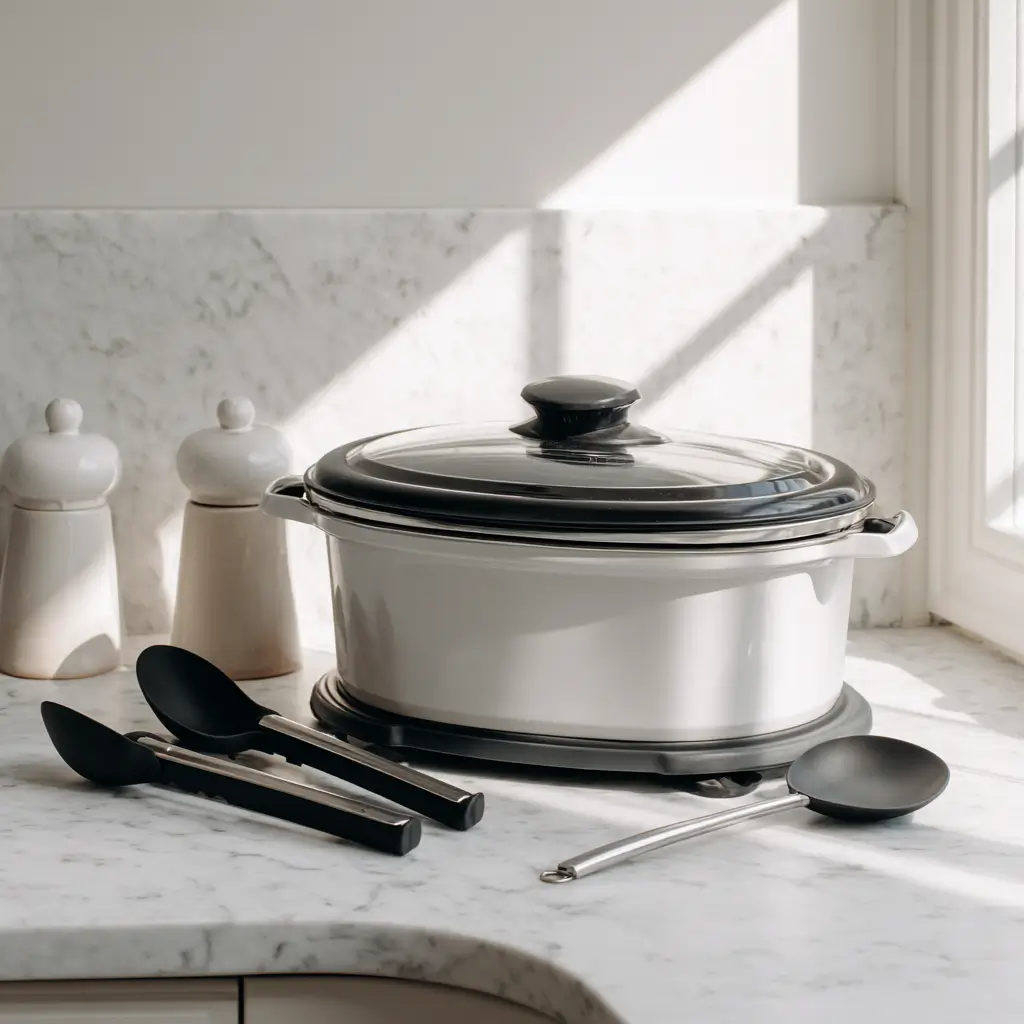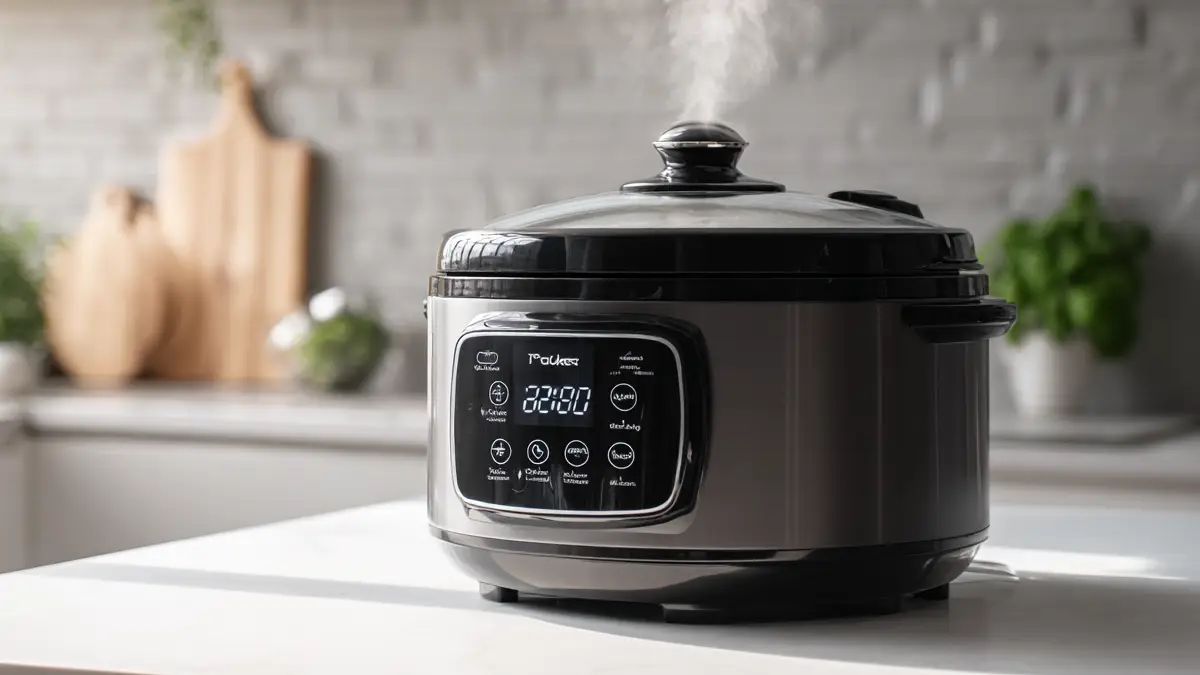Table of Contents
When summer heat rolls in, the last thing anyone wants is to stand over a hot stove. That’s where slow cookers come to the rescue. They let you whip up flavorful meals with minimal effort—and minimal sweat. But to really master summer slow cooking, the right tools make all the difference. From programmable cookers to smart plugs and cleanup liners, the best accessories enhance safety, convenience, and flavor.
In this article, we’ll explore all the must-have tools for summer slow cooking that help you enjoy delicious meals without heating up your home. Whether you’re a seasoned crockpot user or just starting out, these gear tips will boost your kitchen game all summer long.
Let’s dive in.
Liners & Reusable Inserts for Easy Cleanup
Disposable vs. Silicone Liners: Pros and Cons
Cleaning up after cooking in the summer can be a chore—especially when you’d rather be relaxing or enjoying the sunshine. That’s where slow cooker liners come in handy. There are two popular types: disposable plastic liners and reusable silicone inserts.
| Type | Pros | Cons |
|---|---|---|
| Disposable Liners | Easy to toss, no scrubbing needed, widely available | Not eco-friendly, can tear if stirred aggressively |
| Silicone Inserts | Reusable, better for the environment, heat-resistant | Requires washing, may be harder to fit perfectly in some models |
Disposable liners are great for those quick summer meals where cleanup time needs to be zero. But if you’re cooking often during the season, a reusable silicone liner may save money—and reduce waste.

Heat Safety and Performance in High-Temp Summer Use
Summer heat adds another layer of complexity when using plastic or silicone in slow cookers. Always make sure:
- Your liners are BPA-free and FDA-approved for food contact.
- The material is rated for at least 400°F to handle any extended cooking or searing phases.
- You’re using a liner that fits snugly and doesn’t bunch up—this ensures even heat distribution and keeps food from burning on the sides.
Silicone inserts tend to perform better in higher heat situations. They insulate food slightly, which can also help with delicate recipes like dips or desserts.
Reducing Smells, Stains, and Leftover Residue
Nothing ruins a summer vibe like lingering food odors in the house. Liners help with that, too. They reduce the contact your food has with the ceramic or metal pot walls—meaning:
- Less staining from sauces like tomato or curry.
- Fewer smells trapped in porous ceramic.
- Easier deodorizing, since disposable liners can be tossed, and silicone can be deep cleaned.
For stubborn residue or smells, try soaking your silicone insert in a baking soda and vinegar mix overnight.
Heat-Resistant Mats and Safe Placement Tools
Protecting Countertops, Patios, and Picnic Tables
When you’re using your slow cooker in summer, you’re not always in the kitchen. From patios to picnic tables and even RV counters, the surfaces you’re cooking on might not be built to handle heat.
That’s where heat-resistant mats are a true game-changer. These silicone, fiberglass, or cork-based mats:
- Shield delicate counters from heat damage or burn marks
- Prevent scratching from moving slow cookers around
- Add a layer of insulation between the cooker and your table, reducing heat transfer
Some heat mats even double as cutting boards or trivets, making them a multipurpose addition to your summer cooking toolkit.
Portable Trays and Folding Carts for Mobility
Mobility is another underrated factor in summer cooking. Whether you’re moving from kitchen to patio, or setting up in your RV, folding carts and portable trays make things easy—and safer.
Key features to look for:
- Locking wheels to prevent shifting while cooking
- Foldable shelves for compact storage
- Heat-resistant tops for slow cookers and hot dishes
- Storage underneath for liners, utensils, and plugs
A well-designed cart can serve as both your prep station and your serving station, perfect for casual outdoor summer dinners or potlucks.
Best Placement Tips to Maintain Air Circulation
Summer cooking doesn’t just mean controlling heat inside the cooker—it means managing the heat around it too. Poor placement can lead to overheating, power issues, and even fire hazards. Here are a few pro tips:
- Always place your slow cooker on a flat, non-flammable surface
- Keep at least 6 inches of space around the cooker on all sides
- Avoid placing it near walls, paper towels, curtains, or wooden railings
- Don’t trap heat in with tightly sealed lids—use vented lids or crack it open slightly when appropriate
Proper airflow ensures your slow cooker works efficiently and doesn’t heat up the entire area—especially crucial when cooking in small outdoor kitchens, balconies, or dorm rooms.
Smart Plugs and Timers for Convenience
Automating Cooking Routines in Hot Weather
Summer is a season of spontaneity—beach days, barbecues, road trips—and sometimes, your dinner plans get sidelined. That’s where smart plugs and timers come in handy.
With these tools, you can:
- Set your slow cooker to turn on or off automatically, based on your schedule.
- Avoid overheating your kitchen by ensuring meals cook during the cooler part of the day.
- Keep energy usage in check when you’re not home.
Mechanical timers are good for basic control, but smart Wi-Fi-enabled plugs add a whole new level of convenience by allowing app-based control and real-time adjustments, even if you’re miles away.

Wi-Fi and App-Based Remote Control Options
Wi-Fi smart plugs pair easily with platforms like Alexa, Google Assistant, or dedicated apps (like Smart Life). These allow you to:
- Start or stop cooking remotely
- Monitor run time and energy use
- Set alerts or automation rules (like turning off at a specific temperature or time)
Some plugs even offer energy tracking so you can see how much power your slow cooker uses—a great feature for energy-conscious summer cooking.
Safety Tips for Power Use and Surge Protection
Adding technology to your cooking routine is helpful—but only if it’s safe. Follow these tips when using smart plugs or timers with your slow cooker:
- Use plugs that support your cooker’s wattage (usually 200-300W for a typical unit)
- Avoid extension cords—plug directly into the wall outlet whenever possible
- Choose plugs with built-in surge protection
- Place plugs in cool, dry areas to avoid moisture damage during outdoor use
Smart doesn’t mean risky. With a little attention to setup, your smart plug becomes one of the most reliable tools in your summer slow cooking arsenal.
Bonus Tools for Efficiency & Safety
Lid Stands, Tongs, and Ladles for Easy Handling

When cooking in the heat of summer, every second counts—and so does every tool. Handling a hot slow cooker lid without dripping condensation or fumbling can be frustrating. Enter the lid stand—a small but mighty upgrade.
Lid stands help you:
- Avoid messy counters by holding the lid upright
- Keep your hands free for stirring or serving
- Prevent water from dripping back into your dish and thinning out sauces
Pair that with heat-resistant tongs and long-handled ladles to safely stir and serve without reaching into a hot pot. These tools minimize risk, reduce mess, and improve speed.
Spice Racks and Measuring Sets for Faster Prep
Summer cooking favors quick meal prep—and that’s where spice racks and stackable measuring sets shine. A neatly arranged spice rack helps you:
- Access key ingredients faster
- Reduce prep time in hot kitchens
- Keep counters clean and clutter-free
Magnetic spice tins or vertical tiered racks save space, especially if you’re cooking in smaller summer kitchens, like RVs or tiny homes.
Stackable measuring sets—especially those made of silicone or lightweight plastic—are perfect for quick batching. Plus, they clean up easily and often go right in the dishwasher.
Storage Containers Perfect for Batch Summer Meals
Batch cooking is a summer slow cooking secret—cook once, eat twice or more. The key? Proper storage containers that keep leftovers fresh and organized.
Look for:
- BPA-free, microwave-safe plastic or glass containers
- Stackable designs with airtight lids
- Sizes that match your portion needs
Bonus tip: Label with a dry-erase marker so you know what’s inside and when it was cooked. Batch meals like shredded BBQ chicken, veggie chili, or curry freeze beautifully and make excellent grab-and-go lunches.
Where to Start: Building Your Summer Cooking Kit
Must-Have Essentials vs. Optional Extras
If you’re just getting into summer slow cooking, the wide array of tools can feel overwhelming. Don’t worry—you don’t need to buy everything at once. Start with a few essential tools, then gradually add extras to upgrade your routine.
Essentials for every summer slow cook setup:
- A programmable slow cooker with auto-warm function
- Heat-resistant mat or safe placement surface
- Slow cooker liners (disposable or reusable)
- Long-handled tongs or ladles
Optional extras that boost convenience:
- Smart plug or timer for remote control
- Spice rack or measuring tools
- Lid stand and storage containers
- Folding cart or tray table
These extras aren’t mandatory—but once you try them, you’ll wonder how you ever cooked without them.
What to Buy First Based on Your Cooking Style
Your first purchases should reflect how you like to cook and how often. Here’s a quick breakdown:
| Cooking Style | What to Prioritize |
|---|---|
| Set-it-and-forget-it meals | Programmable slow cooker, liners, smart plug |
| Outdoor cooking | Heat-resistant mat, folding cart, power extension |
| Batch cooking | Storage containers, spice rack, measuring sets |
| Small space cooking | Compact cooker, silicone liners, lid stand |
If you’re into prep-ahead meals or feeding a crowd during summer weekends, larger capacity cookers and stackable storage containers should be top of your list.
Budget-Friendly Finds for Beginners
You don’t need to spend a fortune to get started. Many of the most useful slow cooking tools are available at major retailers like Target, Walmart, or Amazon for under $30.
Here are a few smart buys:
- Reusable silicone liners (under $15 for 2-pack)
- Heat-resistant mats (starting at $10)
- Smart plugs with app support (as low as $12)
- Starter utensil sets including ladles and tongs (under $20)
You can also check local yard sales or online marketplaces for secondhand deals—just be sure to verify the condition of anything electrical.
FAQs About Summer Slow Cooker Tools
Are slow cooker liners safe to use?
Yes—as long as they’re labeled BPA-free and made for high-heat cooking, slow cooker liners are generally safe. They’re designed to withstand typical slow cooking temps (usually under 300°F). For added peace of mind, stick to name brands and always follow the manufacturer’s directions.
Can I use smart plugs with my slow cooker?
Absolutely. Smart plugs are compatible with most modern slow cookers, especially those with manual dial settings. Just make sure the plug supports the wattage of your device. For digital cookers, ensure it will resume the cook cycle when powered back on.
Do heat-resistant mats actually work?
Yes, and they’re a must-have for protecting surfaces during summer cooking. They prevent heat damage to counters, tables, or outdoor setups. Look for silicone or fiberglass mats rated for high temps (at least 400°F) for the best results.
How do I choose the right size slow cooker?
It depends on how many people you typically cook for.
3–4 quarts: great for 1–2 people
5–6 quarts: perfect for a family of 3–5
7 quarts or more: ideal for larger groups or batch cooking Also consider storage space and how much food you want for leftovers.
Which slow cooker settings are best for summer?
In summer, low and warm settings are your best friends. They produce less steam and heat than high settings. A programmable model with a built-in auto-warm feature can keep food ready without overcooking or heating the kitchen.
Are reusable silicone inserts better than disposable liners?
In many ways, yes. Silicone liners are eco-friendly, durable, and heat-safe. They cost more upfront, but last much longer and eliminate waste. However, they do require cleaning after each use, whereas disposable liners are toss-and-go.
Should I preheat the slow cooker before using it?
Not always. For most summer recipes like soups, dips, or pulled meats, preheating isn’t required. However, if you’re adding raw meat or want to reduce overall cook time, a 10–15 minute preheat can help food cook more evenly—especially when using liners.
Conclusion
Summer slow cooking is all about smart, low-effort meals that keep your kitchen cool. With the right tools—like programmable cookers, smart plugs, heat mats, and liners—you can cook efficiently without the heat or hassle.
Start with the essentials, then add smart upgrades like lid stands or spice racks to streamline your routine. Simple tools, big summer flavor.
Want more ideas like this? Follow us on Facebook and Pinterest for simple, flavorful recipes!
You might also like these recipes


3 thoughts on “Must-Have Tools for Summer Slow Cooking”